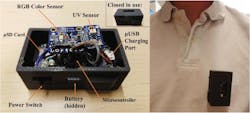Penn State wearable device takes note of outdoor vs indoor light
A team at Pennsylvania State University has become the latest group of scientists and engineers to develop a wearable device that records whether a person is exposed to natural light or artificial light. The Penn State crew hopes that its gadget — roughly the size of a fat and chunky key fob — improves the accuracy of studies that examine the health benefits of being outdoors.
The battery-powered unit includes a sensor that detects ultraviolet (UV) energy, which is typically present in sunlight but not in significant quantities in ordinary indoor artificial light. Another sensor in the 2.3×1.43×1.12-in. plastic box takes note of light intensity and color temperatures, which the team said provides additional evidence as to whether someone has been outside.
Writing in the journal HardwareX, available via ScienceDirect, the team from Penn State's Berk campus, near Reading, PA, claimed that the device will enhance the reliability of studies that measure the health advantages provided by natural light. That's because those studies tend to rely on the potential inaccuracies of individuals recording whether they have been indoors or outdoors.
“Many of the existing studies related to environmental exposure rely on self-reported measures (e.g. survey data) to quantify this time spent outdoors,” wrote author Matthew Rhudy and his colleagues. “The research community, particularly those in the fields of psychology and epidemiology, could greatly benefit from an objective quantification of time spent outdoors. Additionally, exposure to outdoor environments is often conflated with physical activity; two factors that can exert independent influences on health. This concern presents an incentive for environmental exposure measurement to complement currently available means of tracking an individual’s physical activity over time.”
Rhudy is an assistant professor of engineering. He worked with an interdisciplinary team that also included associate professor of psychology Nathan Greenauer and assistant professor of psychology Catherine Mello.
Theirs is not the first such recording device. LEDs Magazine has published articles referencing the wearable Daysimeter developed by the Lighting Research Center as part of Rensselaer Polytechnic Institute (RPI), some five years ago and which traces its roots back about 15 years.
A separate RPI research and engineering group, the Center for Lighting Enabled Systems & Applications (LESA), has also developed a pea-sized spectrometry tool designed to be embedded in eyewear.
The Penn State development is a sure sign of the growing interest in the roles of both natural and artificial light in health and wellbeing.
“Approximately three-quarters of both adults’ and children’s days is spent indoors,” the Penn State team wrote. “Yet existing cross-sectional and longitudinal research suggests a positive association between time spent outdoors and a person’s subjective well-being. Time spent outdoors provides additional benefits, such as lower stress levels and improved sleep. Therefore, determining how much time a person is indoors or outdoors is useful information for understanding moment-to-moment, as well as long-term, physical and mental wellness.”
The team told Penn State's news website that one possible use for the tool would be to nudge people to go outdoors more often.
The core of Penn State's device is an open-sourced Arduino processor from NYC-based Adrafruit Industries. It records onto a microSD card, and does not yet have wireless transmission. The lithium-ion battery recharges via a USB connection, and the unit has an on/off switch.
MARK HALPER is a contributing editor for LEDs Magazine, and an energy, technology, and business journalist ([email protected]).
For up-to-the-minute LED and SSL updates, why not follow us on Twitter? You’ll find curated content and commentary, as well as information on industry events, webcasts, and surveys on our LinkedIn Company Page and our Facebook page.

Mark Halper | Contributing Editor, LEDs Magazine, and Business/Energy/Technology Journalist
Mark Halper is a freelance business, technology, and science journalist who covers everything from media moguls to subatomic particles. Halper has written from locations around the world for TIME Magazine, Fortune, Forbes, the New York Times, the Financial Times, the Guardian, CBS, Wired, and many others. A US citizen living in Britain, he cut his journalism teeth cutting and pasting copy for an English-language daily newspaper in Mexico City. Halper has a BA in history from Cornell University.



![The DesignLights Consortium continues to make progress in shifting outdoor lighting products and implementation practices toward a more restrained and thoughtful strategy. [Image does not represent a DLC qualified fixture.] The DesignLights Consortium continues to make progress in shifting outdoor lighting products and implementation practices toward a more restrained and thoughtful strategy. [Image does not represent a DLC qualified fixture.]](https://img.ledsmagazine.com/files/base/ebm/leds/image/2024/08/66be810888ae93f656446f61-dreamstime_m_265700653.png?auto=format,compress&fit=&q=45&h=139&height=139&w=250&width=250)

